Research on UAV Safety Distance Warning Technology Based on Electric Field Ring Rate of Change
Abstract
1. Introduction
2. Drone Safety Distance Analysis
2.1. Simplified Model Analysis of Transmission Lines
- The industrial frequency electromagnetic fields generated by high-voltage transmission lines should be considered as quasi-static fields;
- The earth is treated as an infinite plane and set as a good conductor, and the potential of the ground is taken to be 0;
- Split conductors of transmission lines are replaced using columns of equivalent radius;
- A complex voltage vector is used to represent the potential to ground of each phase of the transmission line;
- Using the vector form to represent the changes in voltage and current of high-voltage transmission lines and setting the ground as the potential reference point, the representation of the voltage and line current of each phase of the transmission line can be expressed as:
2.2. Establishment of Simulation Model of Electric Field Distribution around the Three-Phase Transmission Line
- Step 1: According to the size and spacing of transmission lines under different voltage levels, a simulation model is directly established in COMSOL multi-physics to simulate the distribution of transmission lines under real conditions;
- Step 2: According to the actual situation, the physical parameters under each part of the model are set, the relative dielectric constant of the air is set to 1, and the material of the transmission line is set to aluminum;
- Step 3: Set the boundary conditions, set the lower surface of the air domain as grounding, and set the rest as zero charge, i.e; set the corresponding voltage on the ABC three-phase transmission line according to Equation (2) and set the initial phase angle to 0. Equation (5) is the obtained three-phase voltage value.
- Step 4: In order to divide the grid more accurately, the transmission line model and the air domain model are divided into grids in the simulation process. The transmission line is set as super fine and the air is set as fine;
- Step 5: In order to make the simulation more accurate, select the iterative solver for research and calculation.
2.3. Determination of Safety Distance at Different Voltage Levels
3. Research on Safe Distance Early Warning Method Based on Electric Field Cycle Change Rate
4. UAV and Transmission Line Safety Early Warning Strategy
5. Signal Acquisition System Design
5.1. One-Dimensional Electric Field Sensor Design
5.2. Three-Dimensional Electric Field Measurement System Design
6. Experimental Platform Construction
7. Conclusions
Author Contributions
Funding
Conflicts of Interest
References
- Li, X.; Li, Z.; Wang, H.; Li, W. Unmanned aerial vehicle for transmission line inspection: Status, standardization, and perspectives. Front. Energy Res. 2021, 9, 336–349. [Google Scholar] [CrossRef]
- Jian, Z.; Shiyong, W.; Xi, C.; Huadong, X.; Dengke, Y.; Zhong, Y. The obstacle avoidance method of UAV patrol based on columnar space and support vector machine. China Electr. Power 2015, 48, 56–60. [Google Scholar]
- Sai, W.; Zhengyi, L.; Xing, G.; Jianguo, W. Early warning system for overhead lines based on computer vision. J. East China Univ. Technol. (Nat. Sci. Ed.) 2013, 39, 482–487. [Google Scholar]
- Song, C.P.; Qian, W.; Ke, W.; Jinju, Q.; Bisheng, Y. Safety distance diagnosis method of LiDAR point cloud for power inspection of large UAVs. Power Grid Technol. 2017, 41, 2746–2753. [Google Scholar]
- Xiangyang, P.; Chi, C.; Xiaogang, X.; Wenxue, X.; Ke, W.; Bisheng, Y.; Xiaoming, M. Safety distance diagnosis technology of transmission channel based on UAV laser scanning. Power Grid Technol. 2014, 11, 3254–3259. [Google Scholar]
- Peng, X.; Chi, C.; Zhangquan, R.; Yang, B.; Mai, X.; Ke, W. Power line safety inspection and intelligent diagnosis based on UAV multi-sensor data acquisition. High Volt. Technol. 2015, 41, 8. [Google Scholar]
- Du, Y.; Peng, Y.; Liu, T.; Liu, T.; Liu, K.; Xu, T.; Tu, M. Experimental Study on Safety Gap Distance of Helicopter Live Work with UHV AC Transmission Line Platform Method. High Volt. Technol. 2015, 41, 1292–1298. [Google Scholar]
- Zheng, Z.; Dong, S.; Deng, X.; Jin, X. Safety distance of UHV double-circuit AC transmission lines on the same tower adjacent to buildings. High Volt. Technol. 2013, 39, 2943–2950. [Google Scholar]
- Xiao, D.; Ma, Q.; Xie, Y.; Zheng, Q.; Zhang, Z. A Power-Frequency Electric Field Sensor for Portable Measurement. Sensor 2018, 18, 1053. [Google Scholar] [CrossRef] [PubMed]
- Linghao, Z.; Sheng, W.; Chao, T.; Jie, Z.; Wei, G. High voltage transmission line electric field detection and distance estimation method design. Sens. Micro Syst. 2020, 39, 75–77,81. [Google Scholar]
- Shaoxiang, C.; Jie, L.; Tengfei, K. Unmanned aerial vehicle power line patrol system based on electric field ranging. Single Chip Microcomput. Embed. Syst. Appl. 2018, 18, 83–87. [Google Scholar]
- Zhang, W.; Ning, Y.; Suo, C. A Method Based on Multi-Sensor Data Fusion for UAV Safety Distance Diagnosis. Electronics 2019, 8, 1467. [Google Scholar] [CrossRef]
- Youhuan, N. Development of UAV Positioning and Early Warning System Based on Field Strength. Master’s Thesis, Kunming University of Technology, Kunming, China, 2020. [Google Scholar]
- Jianjun, L.; He, W.; Guoyu, C.; Qian, Z.; Zheng, W.; Guohua, L.; Chengbo, H. A multi-electrode electric field gradient calculation optimization method based on vector electric field. Power Syst. Prot. Control. 2018, 46, 7. [Google Scholar]
- Songyang, Z.; Degui, Y.; Qing, L. Wireless power frequency electric field measurement and warning instrument and application. Electr. Meas. Instrum. 2011, 48, 21–25. [Google Scholar]
- Wenbin, Z.; Chunping, Y.; Nianrong, Z.; Tang, L.; Gui, J.; Suo, C. Automatic identification method of voltage level of high voltage transmission line based on SVM. Ferroelectrics 2017, 521, 86–93. [Google Scholar]
- Jun, W.; Zhuang, L.; Xiangdong, W.; Yong, D.; Xiaopo, M. Electric field simulation analysis of UAV inspection safety distance in DC transmission lines. Hubei Electr. Power 2017, 41, 14–19. [Google Scholar]
- The National Development and Reform Commission of the People’s Republic of China issued. DL/T 5220-2005 Technical Specifications for the Design of Overhead Distribution Lines under 10 kV; China Electric Power Press: Beijing, China, 2012. [Google Scholar]
- Ministry of Housing and Urban-Rural Development of the People’s Republic of China Organized Compilation. Design Code for 110 kV-750 kV Overhead Transmission Lines; China Plan Press: Beijing, China, 2014. [Google Scholar]
- Rong, A.; Zhengyun, F.; Lijun, T.; Liangjin, F.; Wenbin, Z. Design and Analysis of Power Frequency Electric Field Sensor Units for High Voltage and Near Electric Early Warning. Sens. Microsyst. 2019, 38, 89–91,95. [Google Scholar]
- Hua, L. Research on Discharge Characteristics of Metal Tip Corona. Master’s Thesis, Nanjing University of Information Engineering, Nanjing, China, 2021. [Google Scholar]
- Huiling, W.; Baosheng, L. Electric field simulation analysis of circular capacitive sensor based on edge effect. Sens. Microsyst. 2014, 4, 31–34. [Google Scholar]
- Suo, C.; Wei, R.; Zhang, W.; Li, Y. Research on the Three-Dimensional Power Frequency Electric Field Measurement System. J. Sens. 2021, 2021, 8859022. [Google Scholar] [CrossRef]
- Liangjin, F. The Design and Detection of Power Frequency Electric Field Sensors for Safety Warning of Power Transmission and Transformation Operations. Master’s Thesis, Kunming University of Technology, Kunming, China, 2019. [Google Scholar]

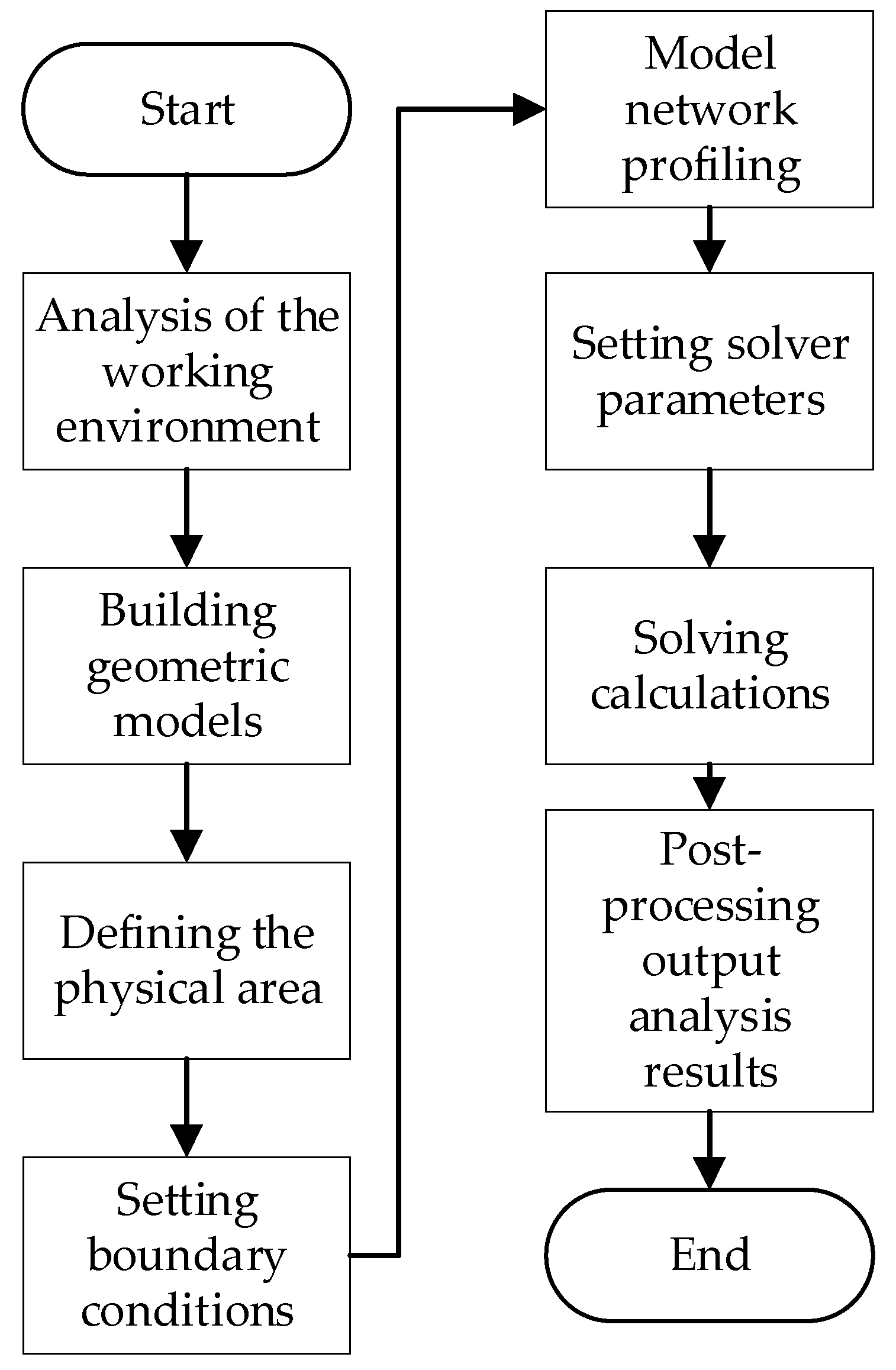
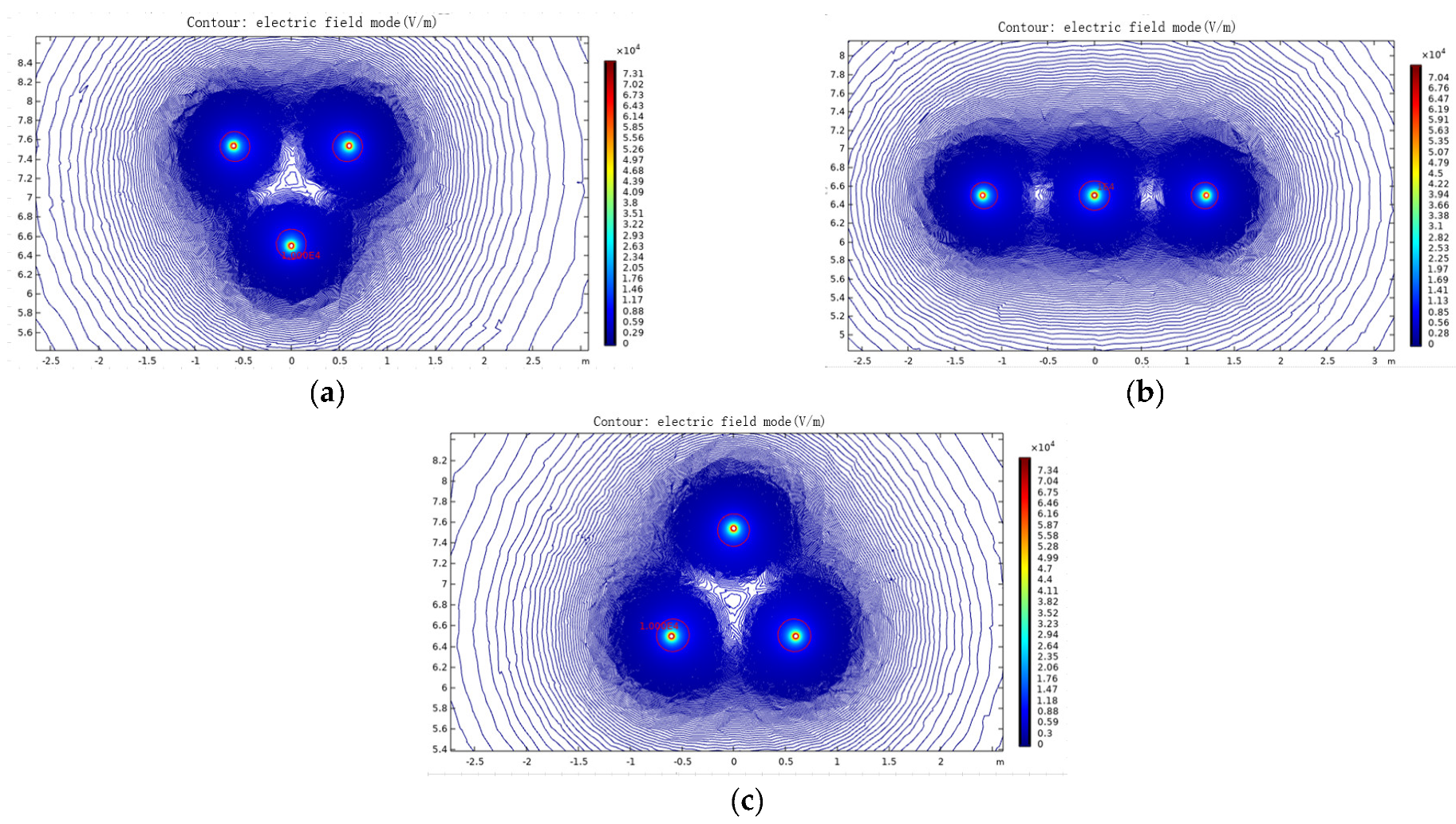


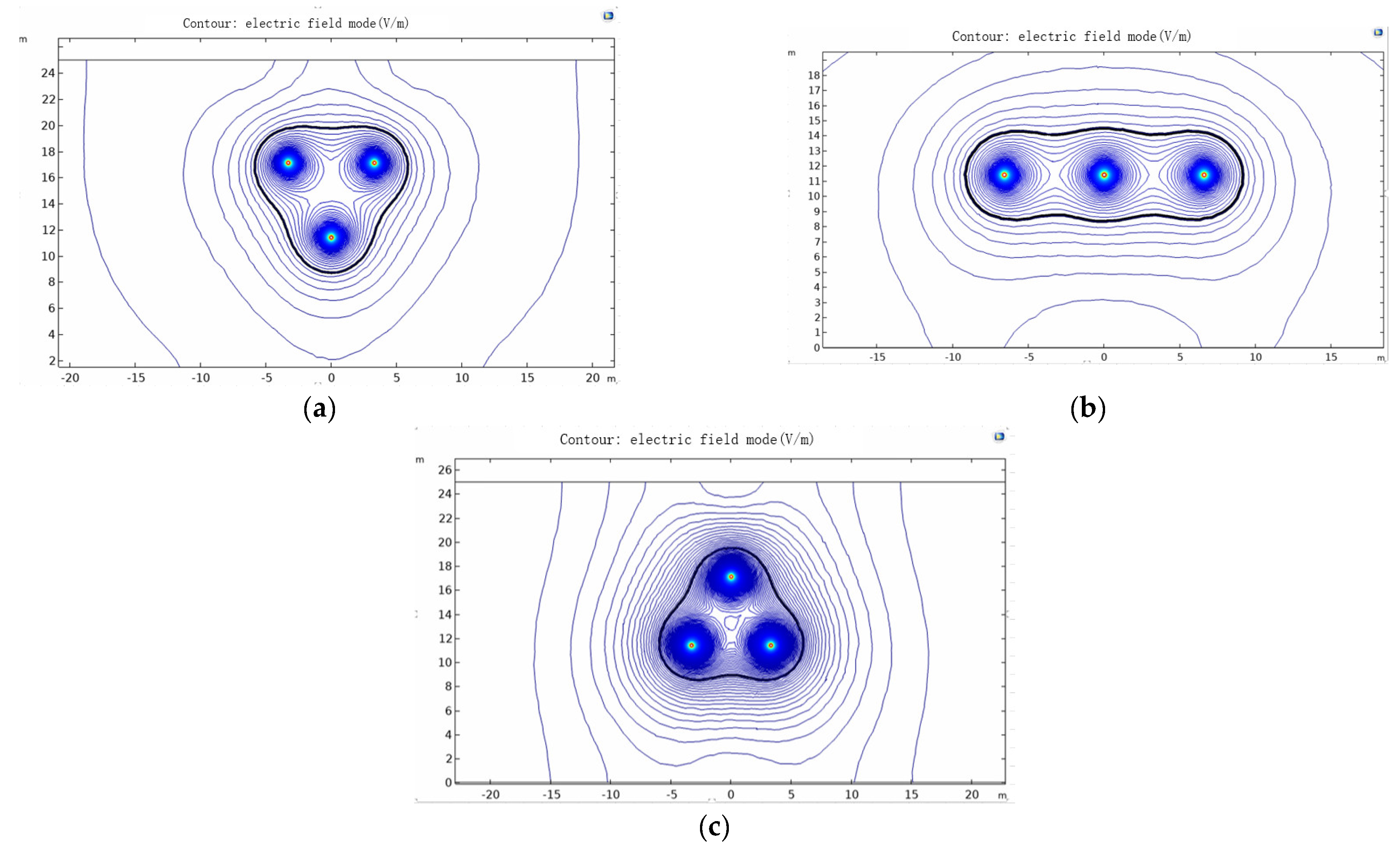


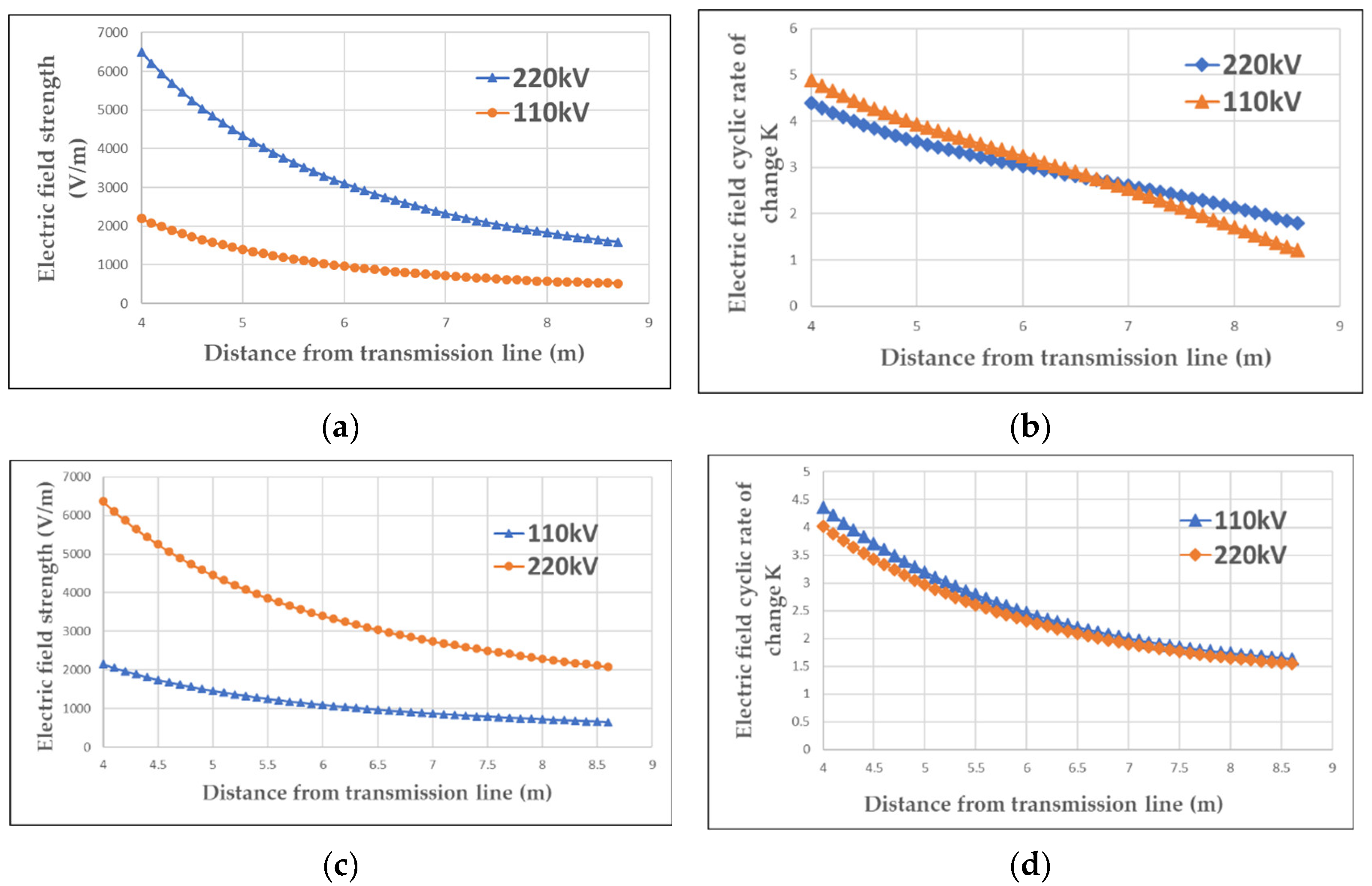
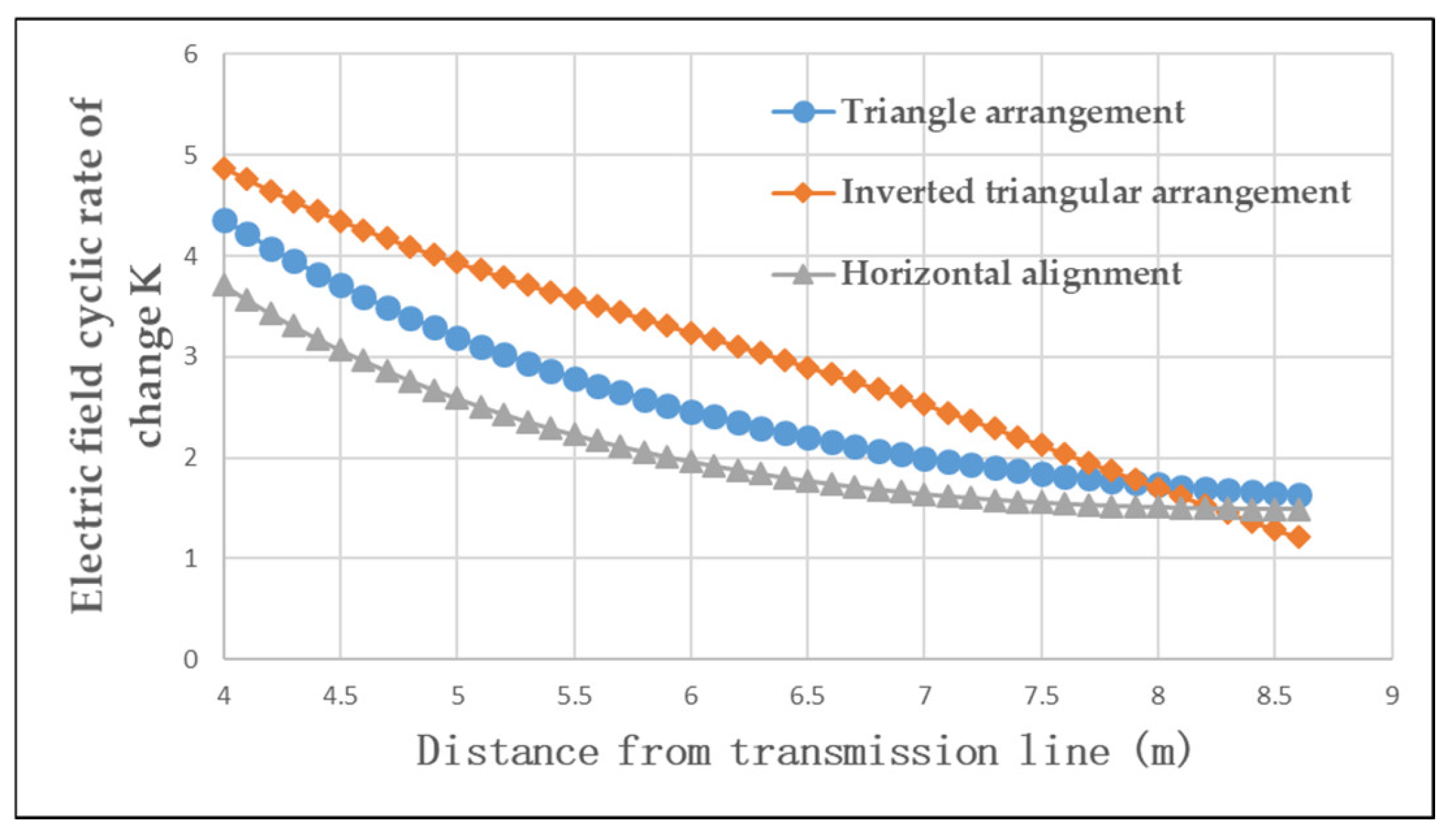
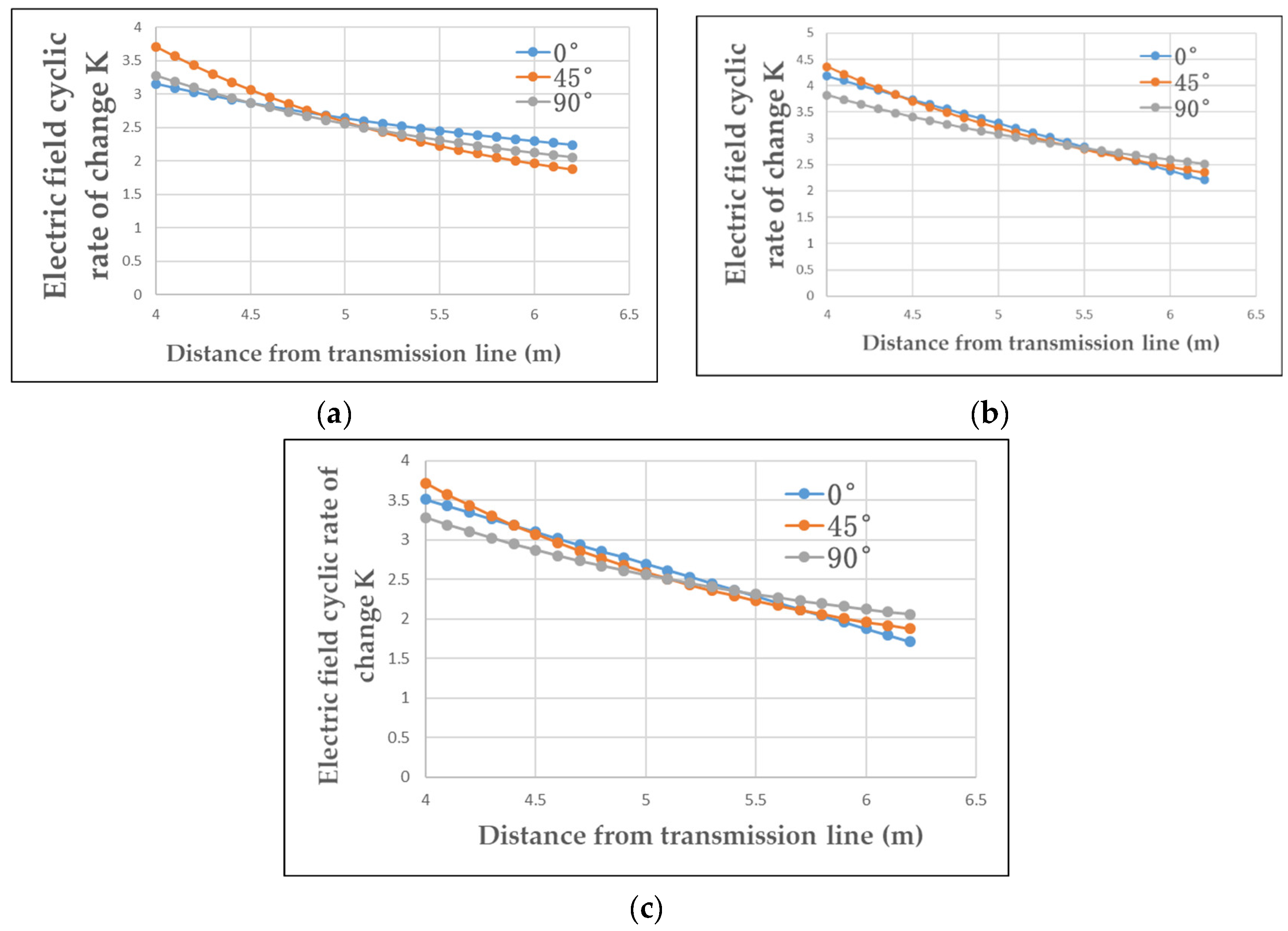

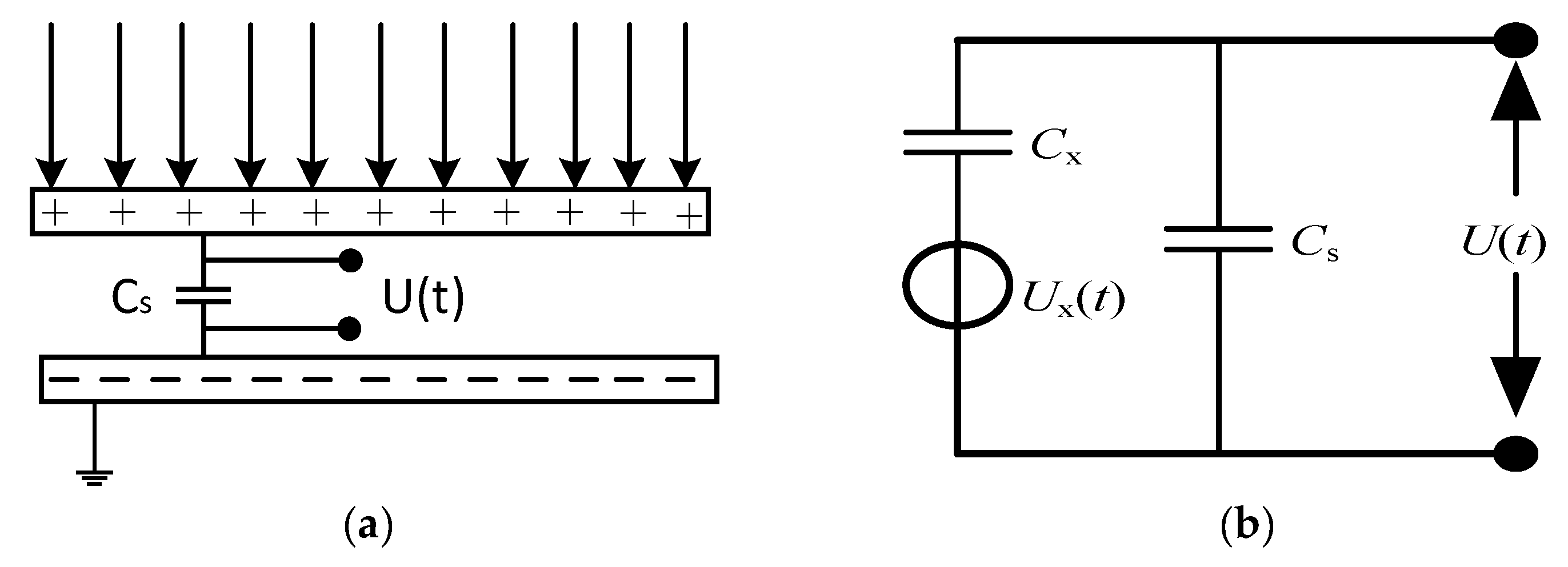
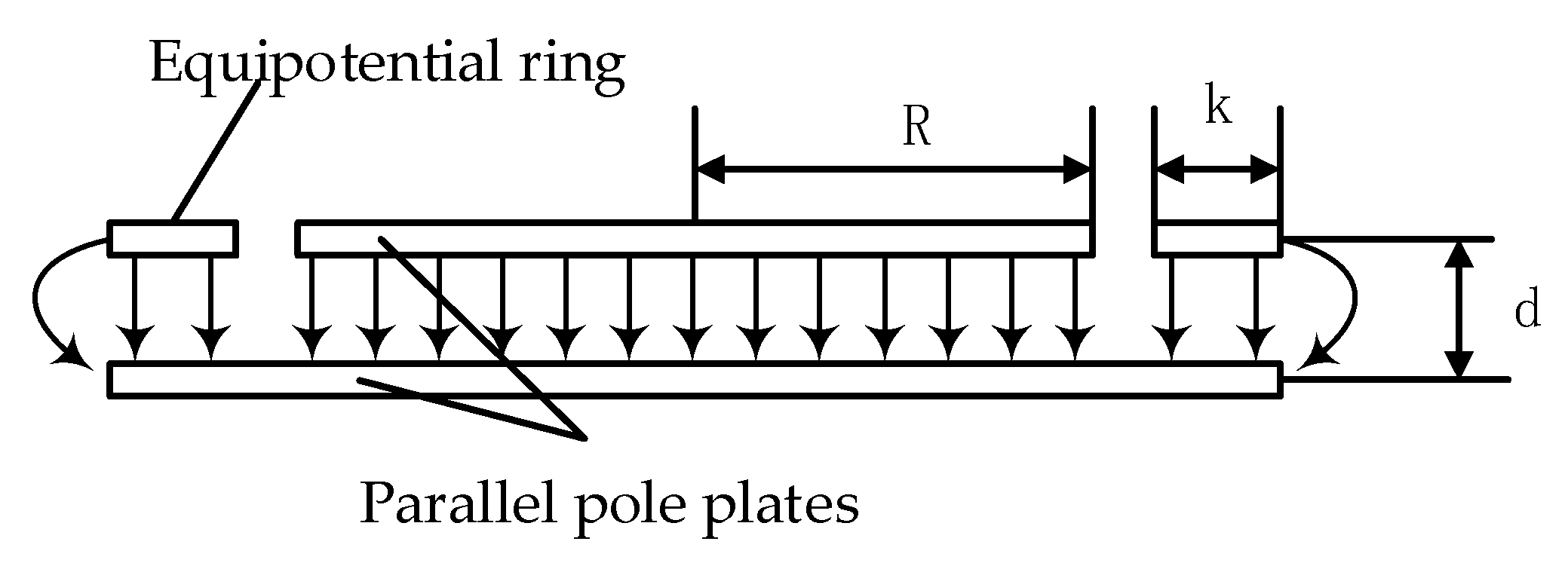

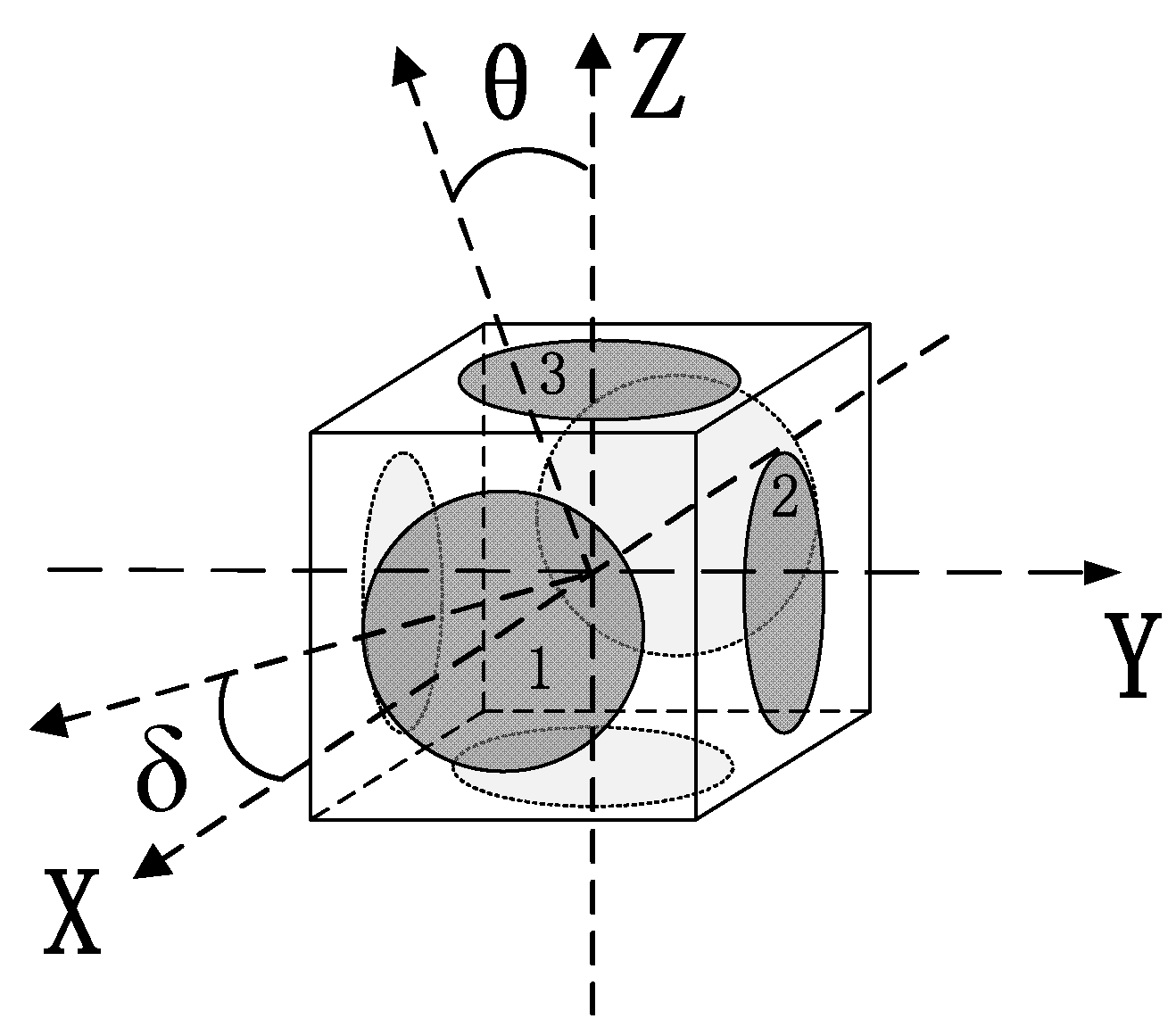




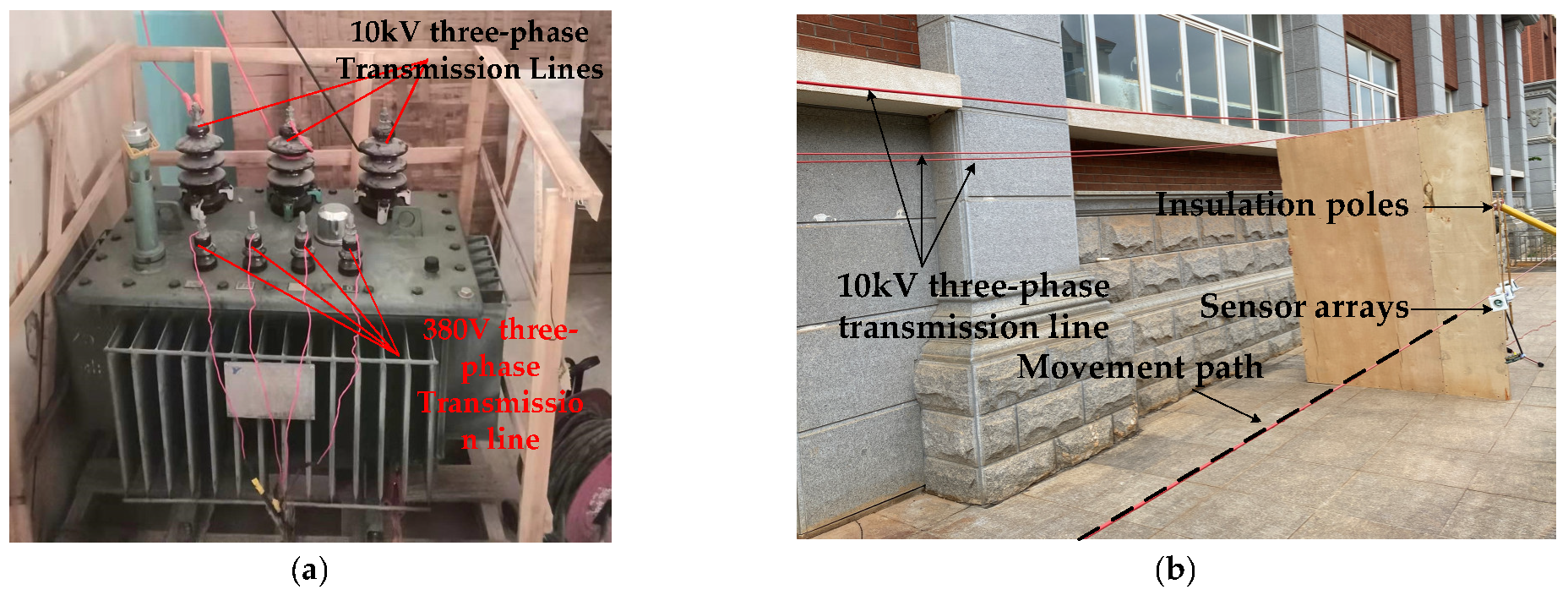

| Voltage Class | Phase Spacing (m) | Transmission Line Diameter (m) | Height above the Ground (m) |
|---|---|---|---|
| 10 kV | 1.2 | 0.0050 | 6.5 |
| 110 kV | 4.2 | 0.0108 | 7.5 |
| 220 kV | 6.6 | 0.0520 | 8.5 |
| Arrangement | Horizontal Arrangement | Regular Triangle Arrangement | Inverted Triangle Arrangement | Maximum |
|---|---|---|---|---|
| Safety distance (m) | 0.15 | 0.16 | 0.15 | 0.16 |
| Arrangement | Horizontal Arrangement | Regular Triangle Arrangement | Inverted Triangle Arrangement | Maximum |
|---|---|---|---|---|
| Safety distance (m) | 1.83 | 2.00 | 2.30 | 2.30 |
| Arrangement | Horizontal Arrangement | Regular Triangle Arrangement | Inverted Triangle Arrangement | Maximum |
|---|---|---|---|---|
| Safety distance (m) | 3.7 | 3.9 | 3.6 | 3.9 |
| Distance from Transmission Line(m) | Electric Field Strength (V/m) | Electric Field Ring Rate of Change |
|---|---|---|
| 0.7 | 1561 | 17.93722 |
| 0.8 | 1281 | 12.41218 |
| 0.9 | 1122 | 14.082 |
| 1.0 | 964 | 11.30705 |
| 1.1 | 855 | 11.57895 |
| 1.2 | 756 | 12.83069 |
| 1.3 | 659 | 7.435508 |
| 1.4 | 610 | 8.852459 |
| 1.5 | 556 | 8.453237 |
| 1.6 | 509 | 7.858546 |
| 1.7 | 469 | 8.315565 |
| 1.8 | 430 | 9.767442 |
| 1.9 | 388 | 4.639175 |
| 2.0 | 370 | 5.945946 |
| 2.1 | 348 | 6.321839 |
| 2.2 | 326 | 7.055215 |
| 2.3 | 303 | 5.940594 |
| 2.4 | 285 | 6.315789 |
| 2.5 | 267 | 5.617978 |
Publisher’s Note: MDPI stays neutral with regard to jurisdictional claims in published maps and institutional affiliations. |
© 2022 by the authors. Licensee MDPI, Basel, Switzerland. This article is an open access article distributed under the terms and conditions of the Creative Commons Attribution (CC BY) license (https://creativecommons.org/licenses/by/4.0/).
Share and Cite
Zhou, N.; Li, J.; Zhang, W.; Zhao, J.; Zhao, J. Research on UAV Safety Distance Warning Technology Based on Electric Field Ring Rate of Change. Electronics 2022, 11, 3439. https://doi.org/10.3390/electronics11213439
Zhou N, Li J, Zhang W, Zhao J, Zhao J. Research on UAV Safety Distance Warning Technology Based on Electric Field Ring Rate of Change. Electronics. 2022; 11(21):3439. https://doi.org/10.3390/electronics11213439
Chicago/Turabian StyleZhou, Nianrong, Jian Li, Wenbin Zhang, Jiawen Zhao, and Jingjing Zhao. 2022. "Research on UAV Safety Distance Warning Technology Based on Electric Field Ring Rate of Change" Electronics 11, no. 21: 3439. https://doi.org/10.3390/electronics11213439
APA StyleZhou, N., Li, J., Zhang, W., Zhao, J., & Zhao, J. (2022). Research on UAV Safety Distance Warning Technology Based on Electric Field Ring Rate of Change. Electronics, 11(21), 3439. https://doi.org/10.3390/electronics11213439





